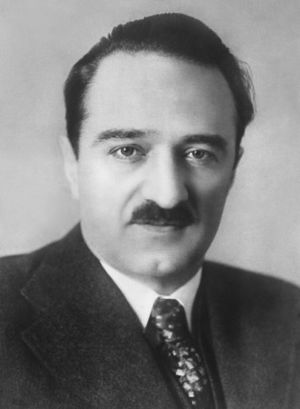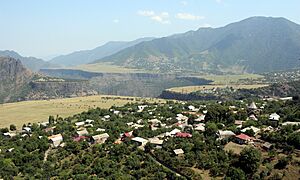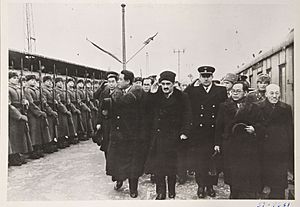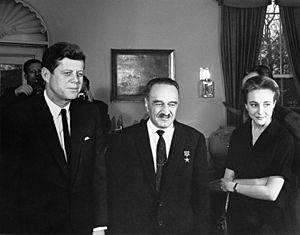Anastas Mikoyan facts for kids
Quick facts for kids
Anastas Mikoyan
Анастас Микоян Անաստաս Միկոյան |
|||||||||||||||||||||||||||||||||||||||||
|---|---|---|---|---|---|---|---|---|---|---|---|---|---|---|---|---|---|---|---|---|---|---|---|---|---|---|---|---|---|---|---|---|---|---|---|---|---|---|---|---|---|

Mikoyan in 1941
|
|||||||||||||||||||||||||||||||||||||||||
| Chairman of the Presidium of the Supreme Soviet |
|||||||||||||||||||||||||||||||||||||||||
| In office 15 July 1964 – 9 December 1965 |
|||||||||||||||||||||||||||||||||||||||||
| Preceded by | Leonid Brezhnev | ||||||||||||||||||||||||||||||||||||||||
| Succeeded by | Nikolai Podgorny | ||||||||||||||||||||||||||||||||||||||||
| First Deputy Chairman of the Council of Ministers of the Soviet Union |
|||||||||||||||||||||||||||||||||||||||||
| In office 28 February 1955 – 15 July 1964 |
|||||||||||||||||||||||||||||||||||||||||
| Premier | Nikolai Bulganin Nikita Khrushchev |
||||||||||||||||||||||||||||||||||||||||
| Preceded by | Nikolai Bulganin | ||||||||||||||||||||||||||||||||||||||||
| Succeeded by | Mikhail Pervukhin | ||||||||||||||||||||||||||||||||||||||||
|
|||||||||||||||||||||||||||||||||||||||||
| Personal details | |||||||||||||||||||||||||||||||||||||||||
| Born |
Anastas Ovaneysovich Mikoyan
25 November 1895 Sanahin, Tiflis Governorate, Russian Empire |
||||||||||||||||||||||||||||||||||||||||
| Died | 21 October 1978 (aged 82) Moscow, Russian SFSR, Soviet Union |
||||||||||||||||||||||||||||||||||||||||
| Resting place | Novodevichy Cemetery, Moscow | ||||||||||||||||||||||||||||||||||||||||
| Citizenship | Soviet | ||||||||||||||||||||||||||||||||||||||||
| Nationality | Armenian | ||||||||||||||||||||||||||||||||||||||||
| Political party | CPSU (1918–1966) | ||||||||||||||||||||||||||||||||||||||||
| Other political affiliations |
RSDLP (Bolsheviks) (1915–1918) | ||||||||||||||||||||||||||||||||||||||||
| Spouse |
Ashkhen Tumanyan
(m. 1920; died 1962) |
||||||||||||||||||||||||||||||||||||||||
| Children | 5 (Stepan, Vladimir, Aleksei, Vano, and Sergo) | ||||||||||||||||||||||||||||||||||||||||
| Occupation | Civil servant, statesman | ||||||||||||||||||||||||||||||||||||||||
| Signature | |||||||||||||||||||||||||||||||||||||||||
Anastas Ivanovich Mikoyan (English: /miːkoʊˈjɑːn/; Russian: Анаста́с Ива́нович Микоя́н; Armenian: Անաստաս Հովհաննեսի Միկոյան; 25 November 1895 – 21 October 1978) was an important Armenian politician and leader in the Soviet Union. He was special because he stayed in power for a very long time. He worked with leaders like Lenin, Stalin, and Khrushchev. He even retired peacefully under Brezhnev.
Mikoyan joined the Bolsheviks (a political group) early on. He was part of the Baku Commune during the Russian Civil War. In the 1920s, he was a key leader in the North Caucasus region. During Stalin's time, Mikoyan held many high government jobs. This included being the Minister of Foreign Trade.
Later, Mikoyan helped Khrushchev with the "de-Stalinization" policy. This policy aimed to move away from Stalin's harsh rule. Mikoyan became the First Deputy Premier under Khrushchev. This made him the second most powerful person in the Soviet Union at that time.
Mikoyan also traveled a lot for diplomacy. He visited Cuba and the United States. He was very skilled at using "soft power" to help Soviet interests. In 1964, Khrushchev was removed from power. Mikoyan then became the Chairman of the Presidium of the Supreme Soviet. This was a mostly ceremonial role. He retired in 1965.
Contents
Early Life and Political Start

Anastas Mikoyan was born in 1895 in Sanahin, a village in what is now Armenia. His parents were Armenian. His father was a carpenter and his mother was a rug weaver. His younger brother, Artem Mikoyan, later helped create the famous MiG airplane design company.
Mikoyan went to school in Tiflis and Vagharshapat. These schools were linked to the Armenian Church. However, he became less religious as he studied more. He later said that studying religion made him believe in atheism even more. Before politics, he also studied liberalism and socialism.
At age twenty, he helped form a workers' council in Echmiadzin. In 1915, Mikoyan officially joined the Bolshevik group. This group later became the Bolshevik Party. He became a leader in the revolutionary movement in the Caucasus. He also worked as an editor for Armenian and Russian newspapers.
Baku Commune and Civil War
After the February Revolution in 1917, Mikoyan and other Bolsheviks fought against groups that opposed them. Mikoyan became a commissar in the Red Army. He fought in Baku and was wounded. He also helped save the life of another Party member, Sergo Ordzhonikidze.
He then helped create the Baku Commune with Stepan Shaumian. Mikoyan edited the commune's Armenian newspaper. He also oversaw its armed Armenian militia. He helped defend Baku against the advancing Turkish army in 1918.
After Baku fell, Shaumian and other Bolshevik leaders were arrested. Mikoyan helped them escape from prison. They tried to flee across the Caspian Sea. But they were arrested again in Krasnovodsk. Many leaders, including Shaumian, were executed. Mikoyan was lucky and avoided this fate.
After being released in 1919, Mikoyan went back to Baku. He continued his Party work there. Later, he became Secretary of the South East Bureau of the Communist Party. In 1923, he was elected to the Central Committee. He stayed a member for over 50 years.
A Member of the Politburo

Mikoyan supported Stalin after Lenin died in 1924. He became the People's Commissar for External and Internal Trade in 1926. In this role, he brought new ideas from the West to the Soviet Union. For example, he introduced the making of canned goods.
In 1935, he was elected to the Politburo. He was one of the first Soviet leaders to visit the United States. He wanted to improve economic cooperation. Mikoyan spent three months in the US. He learned about the American food industry. He also met Henry Ford and visited Macy's in New York City.
When he returned, Mikoyan brought many popular American products to the Soviet Union. These included hamburgers, ice cream, corn flakes, popcorn, and tomato juice. He also led a project to create a home cookbook. This book, The Book of Tasty and Healthy Food, was very popular. Mikoyan also helped start ice cream production in the USSR. He even personally checked its quality. Stalin once joked, "You, Anastas, care more about ice cream than about communism."
World War II and After
When Nazi Germany invaded the Soviet Union in 1941, Mikoyan was put in charge of moving food and supplies. His son Vladimir, a pilot, died in combat during the Battle of Stalingrad. Mikoyan's main job during the war was to supply the Red Army with everything they needed.
Mikoyan also played a big role in moving Soviet factories. In 1941, he helped move industries from western cities like Moscow and Leningrad. They were moved eastward to safer areas like the Ural Mountains.
In 1943, he received the Hero of Socialist Labor award for his efforts. After the war, in 1946, he became the Vice-Premier. As Minister of Foreign Trade, he was responsible for taking apart factories in Soviet-occupied Eastern Germany. These parts were sent to the Soviet Union as reparations.
De-Stalinization and Khrushchev's Ally

After Stalin's death in 1953, Mikoyan remained in the government. He supported Nikita Khrushchev in the power struggle to become the new leader. Because of his help, Mikoyan became First Deputy Premier.
In 1956, Mikoyan helped Khrushchev deliver the "Secret Speech". In this speech, Khrushchev criticized Stalin's personality cult. Mikoyan was actually the first to give an anti-Stalinist speech at the 20th Party Congress. He and Khrushchev worked to ease some of the strict rules on national cultures from Stalin's time. For example, he encouraged Armenians to republish works by writers who had been banned.
In 1957, some leaders tried to remove Khrushchev from power. Mikoyan refused to support them. This secured his place as one of Khrushchev's closest allies. He supported Khrushchev because he believed in de-Stalinization. He also thought that if the plotters won, it could lead to more purges.
Foreign Diplomacy

Mikoyan was very active in foreign diplomacy. He was the first Politburo member to meet Mao Zedong, the leader of the Communist Party of China.
Hungary
In 1956, Mikoyan visited Hungary to help remove the dictator Mátyás Rákosi. He returned later that year during the revolution against the government. Mikoyan believed that using Soviet troops would harm the Soviet Union's international image. He argued for using "military intimidation" and economic pressure instead. The Soviet forces crushed the revolution, and this almost made Mikoyan resign.
United States
As Khrushchev's main representative, Mikoyan visited the United States several times. Even though it was the Cold War, many Americans welcomed him. He was seen as flexible and less rigid than other Soviet politicians.
In 1959, Mikoyan made a special diplomatic trip to the US. He was the first high-ranking Soviet official to visit the US leadership. He acted very informally, asking for a "fortnight's holiday" to visit a friend. He spoke to important American groups, hoping for a more peaceful relationship between the two countries.
He also visited places like a Howard Johnson's restaurant and Macy's Department Store in New York City. He met celebrities in Hollywood. He then met with President Dwight Eisenhower. Even though he didn't change US policy on Berlin, he was praised for easing international tensions. He used "soft diplomacy" which was well-received by the American public.
Mikoyan disagreed with Khrushchev's walkout from the 1960 Paris Summit over the U-2 Crisis of 1960. He felt it kept Cold War tensions high. However, he remained Khrushchev's closest ally.
In 1963, Mikoyan represented the USSR at President John F. Kennedy's funeral. He was visibly upset by the president's death. Jacqueline Kennedy spoke to him, asking him to tell Khrushchev that they must continue her husband's work for peace.
Cuba and the Missile Crisis
The Soviet government welcomed Fidel Castro's takeover in Cuba in 1959. Khrushchev saw Cuba as a potential ally. He sent Mikoyan as a top diplomat to Latin America. Mikoyan was the first Soviet official to visit Cuba after the revolution. He helped secure important trade agreements with the new government.
Khrushchev later decided to send Soviet missiles to Cuba. Mikoyan was against this idea. He was even more against giving Cuba control over the missiles. In November 1962, after the US and Soviet Union agreed to remove the missiles, Khrushchev sent Mikoyan to Havana. His job was to convince Castro to agree to the withdrawal.
Just before starting talks with Castro, Mikoyan learned his wife, Ashkhen, had died in Moscow. Instead of returning for the funeral, he stayed in Cuba. Castro was very firm about keeping the missiles. But Mikoyan worked hard to convince him otherwise. After weeks of difficult talks, Castro finally agreed. The missiles and bombers were removed in December 1962.
Head of State and Retirement
On July 15, 1964, Mikoyan became the Chairman of the Presidium of the Supreme Soviet. This was a mostly ceremonial role. His health was declining, and he was getting old.
Some historians believe Mikoyan thought Khrushchev was becoming a problem for the Party. They think he was involved in the October 1964 coup that brought Brezhnev and Alexei Kosygin to power. However, others say Mikoyan was the only one who defended Khrushchev. Still, he voted to force Khrushchev's retirement to make the vote unanimous. Mikoyan was the only one of Khrushchev's colleagues who wished him well in retirement. He also visited Khrushchev at his home years later.
Because he partly defended Khrushchev, Mikoyan lost his high standing with the new leaders. The Politburo made him retire from his seat due to old age. He also lost his post as head of state. Nikolai Podgorny replaced him on December 9, 1965.
In retirement, Mikoyan wrote his memoirs about his political career. He died on October 21, 1978, at age 82. He was buried in Novodevichy Cemetery in Moscow. He received the Order of Lenin six times.
Personality and Legacy
Historians describe Mikoyan as smart, careful, clever, and hardworking. He spoke several languages, including Armenian, Russian, English, and German. Unlike many others, Mikoyan was not afraid to argue with Stalin. Khrushchev called him a "true cavalier." However, Khrushchev also warned about trusting "that shrewd fox from the east."
Mikoyan had five sons and adopted two more children. He had so many children that he and his wife faced money problems. His wife would sometimes borrow money from other Politburo wives.
Mikoyan was very proud of his Armenian heritage. He even discussed the treatment of Armenians in Turkey with US Vice President Richard Nixon in 1959. He enjoyed meeting other Armenians abroad.
In modern Armenia, Mikoyan's legacy is debated. Some criticize his role in the purges of the 1930s. Others praise his role on the world stage and his efforts to calm the Cuban Missile Crisis. Many also point to his important role in de-Stalinization in Armenia. He supported major economic projects in Armenia. He also maintained good relations with the head of the Armenian Church.
Mikoyan was known as the "Survivor" because he was one of the few old Bolsheviks who avoided Stalin's purges. He was able to retire comfortably from political life. A popular Russian saying about him was: "From Ilyich [Lenin] to Ilyich [Brezhnev]... without heart attack or stroke!"
Portrayals
Paul Whitehouse played Mikoyan in the 2017 movie The Death of Stalin.
Decorations and Awards
- Hero of Socialist Labour
- Order of Lenin, six times
- Order of the October Revolution
- Order of the Red Banner
See also
 In Spanish: Anastás Mikoyán para niños
In Spanish: Anastás Mikoyán para niños



